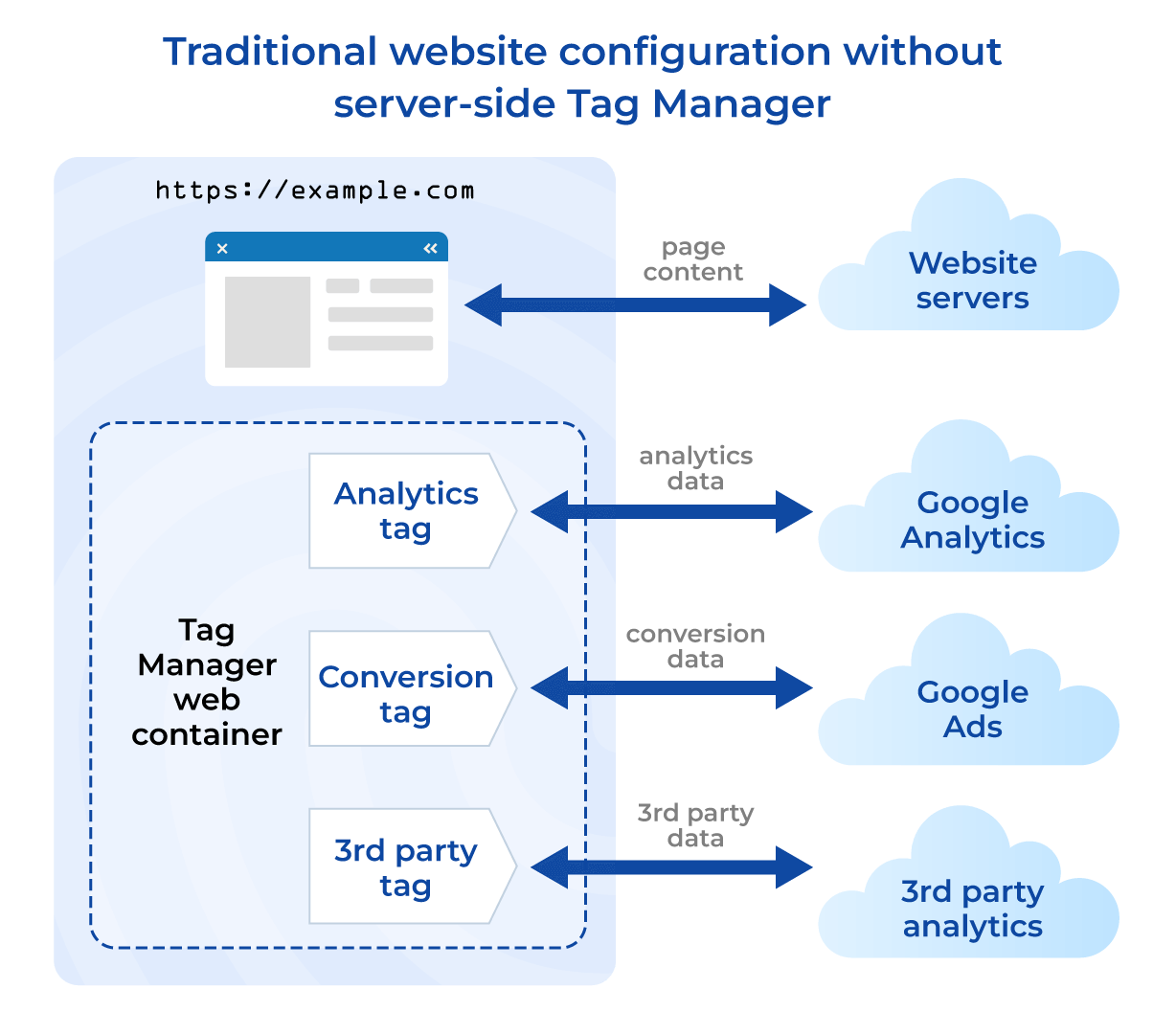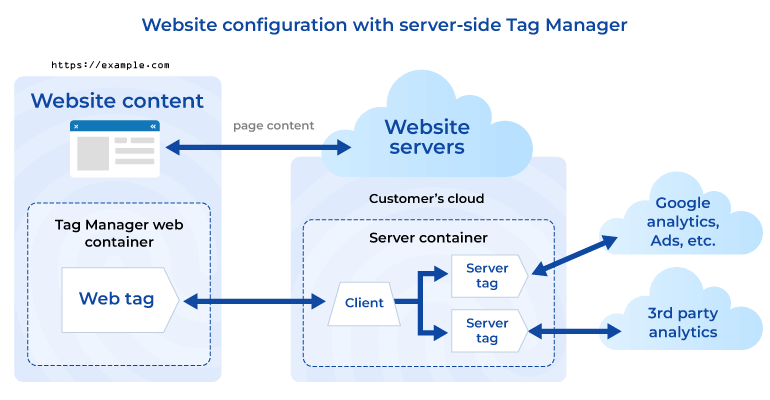What comes after third-party cookies?
As we wave goodbye to third-party cookies, businesses are facing a big shake-up. Website operators need a new way to identify users, learn about their activities, and share data with partners in a way that’s privacy-compliant and not browser-dependent.
Server-side tagging (SST) is a part of this next evolutionary leap forward. It’s a sophisticated and privacy-focused solution that’s gaining momentum as a way to help companies collect online data.
What is server-side tagging?
Server-side tagging is a different approach to tracking data. Instead of relying on third-party services like Google or HubSpot, you shift control to your company. Using server-side tagging, both your website and your users’ data are hosted on a secure, centralized server, giving you more control and protection over users’ personal data, as required by data privacy regulations.
Server-side tags act as a centralized, protective buffer between your users and third-party vendors seeking to track data. Therefore, third parties do not have direct access to data collection from websites, including users’ personal data. This helps ensure better control and security.
Google Tag Manager server-side tagging
Google Tag Manager’s (GTM) server-side tagging is a powerful tool that enables website operators to manage tags, triggers, and variables on a server instead of the user’s browser. It’s a popular and widely adopted solution among marketers and developers because of its ease of use.
GTM’s server-side tagging shifts tag management from the user’s browser to a server managed by your company, offering benefits like improved website performance, better data quality control, and enhanced privacy compliance. It’s ideal for companies needing more data control and better website performance, especially those handling sensitive data or prioritizing privacy compliance.
What is server-side tracking?
Although server-side tracking and tagging both use a server for data management, the two concepts shouldn’t be confused. Server-side tagging refers to the implementation of tracking tags on the server side.
Server-side tracking refers to gathering data straight from the server instead of solely depending on the client’s browser. This method boosts data accuracy, lessens the workload on the client’s side, and can enhance your website’s performance.
Google Analytics server-side tracking
Google Analytics is a popular tool for server-side tracking because it’s user-friendly, integrates with many existing platforms, and has a strong community of users and developers who provide guidance and support.
Google Analytics server-side tracking involves sending data directly from the server to Google Analytics, thus bypassing the user’s browser. Doing so improves your website performance, enhances data privacy, and offers better data quality control.
Client-side tagging vs. Server-side tagging
Both client-side and server-side tagging enable the collection and delivery of data, and each has benefits.
Client-side tagging is the most widely used system. It uses tags and the user’s browser data, which is directly transmitted to one or more servers. Tag management uses this functionality to share data from your website with marketing technology partners. However, there is no centralized control over the data or access to it in this model.

In server-side tagging, data from tags or pixels is sent to your web server. Then, this is forwarded to destination servers, like those used by marketing partners or analytics providers. This method offers centralized control over data access and usage conditions. There is one data stream, which both enables and controls relevant services’ access to the data. It enables granular user consent, allowing some web technologies while blocking others.

Our partner Tealium has an excellent article to learn more: Choosing Between Client-side and Server-side Data Management.
Who is server-side tagging for?
Server-side tagging is best for organizations seeking enhanced data control, improved privacy, and better data quality. For example, organizations dealing with sensitive personal data can use server-side tagging to control and modify data before distributing it to third parties.
Moreover, server-side tagging benefits marketing teams aiming to improve visibility throughout the purchasing cycle and boost conversion rates and return on investment from advertising efforts. This approach offers enhanced control over data collection and distribution, resulting in more precise insights and improved decision-making capabilities.
Lastly, website visitors benefit from improved privacy and security for their data. As once their consent choices are received, it can be better communicated across systems to ensure no data collection or sharing without their consent. Thus boosting trust levels with your website visitors and customers.
Server-side tagging benefits
Implementing server-side tagging benefits multiple parties.
Server-side tagging benefits for businesses
Moving data processing and distribution to the server not only enhances website performance by eliminating the need for heavy third-party technologies and container tags but also provides website administrators with greater control and auditability over shared data with third parties. This shift bolsters website security by limiting access to the website and its data, making it foundational for establishing a corporate data strategy despite the increased costs, such as those for a dedicated web server.
Furthermore, as third-party cookies disappear, small businesses will also benefit from these technologies. Server-side tagging leverages first-party server capabilities to bring tracking closer to website content, preventing ad blockers from blocking content and thwarting Safari’s Intelligent Tracking Prevention (ITP) from shortening HTTP cookie lifetimes or deleting those cookies entirely.
Lastly, marketing teams also see advantages, such as better visibility into the purchasing cycle and improved conversion rates and ROI on advertising.
Server-side tagging benefits for website visitors
Server-side tagging also enhances the privacy and security of your website visitors by ensuring that their consent choices are effectively communicated across systems, preventing unauthorized data collection or sharing. This approach also limits access to and control over collected data, with companies retaining control rather than third-party vendors having direct access. Improved targeting for ads is possible, enabling personalization while preserving privacy.
Although server-side tagging may reduce visibility for users in their browsers regarding data collection and sharing, Usercentrics is collaborating with tagging platforms to restore this visibility. By integrating the Consent Management Platform (CMP), information about data collection and purposes will be extracted and shared with website visitors through the consent banner.
Server-side tagging benefits for third-party vendors
SST provides third-party vendors, such as those offering customer data platforms or data warehouse solutions, with reassurance that granular consent has been obtained from users regarding their data and any associated activities. This reduces the risk of data privacy violations and unauthorized data access since there is more control.
Companies can also develop better communication and shared insights with vendors as the business centralizes its control over website behavior and determines data flow.
How can I implement server-side tagging?
To implement server-side tagging, you will need to work with a tag management system that supports server-side tagging. You will also need to set up a web server or use a cloud-based solution that supports server-side tagging. Once you have these in place, you can start implementing server-side tagging on your website.
Is server-side tagging GDPR-compliant?
The short answer is yes, server-side tagging can be GDPR-compliant. However, you will need to ensure that you obtain granular consent from users for their data and any activities undertaken with it. You will also need to have appropriate data protection measures in place to protect user data.
If you’re using Google Tag Manager server-side tagging, you can pair that with Google Consent Mode to make your tags more GDPR compliant. As it allows websites to communicate a user’s cookie consent choices effectively to Google tags. This mode works by adjusting tag behavior based on the user’s preferences, ensuring that tags respect these choices.
Usercentrics Web & Apps CMP are Google-certified, fully supporting Transparency and Consent Framework (TCF) and Google Consent Mode v2.
It’s worth noting that implementing server-side tags doesn’t automatically make you compliant with the ePrivacy Directive, which is a set of privacy compliance guidelines separate from the GDPR, which complements and expands upon the GDPR’s data protection regulations.
Server-side tagging and cookies
Server-side tagging doesn’t mean you wave goodbye to all cookies. Whether you use Google server-side tagging or another tool, you will still be using cookies. Why? Because cookies are used to monitor user interactions and sustain states, reducing dependence on client-side cookies alone.
Unlike client-side cookies, server-side cookies are managed directly via the server of your choice. Thus offering enhanced flexibility and more control over your data management processes.
So server-side cookies are not a bad thing. They will help you to be more GDPR compliant by providing you with additional control over data handling and user privacy.
Next steps with server-side tagging and privacy-centric marketing
The end of third-party cookies has been talked about for quite some time, but it is actually happening. Google started phasing out third-party cookies with the goal of deprecating their use completely in the Chrome browser. However, the company has pushed back the deadline to complete this change several times.
Fortunately, there are replacement options to obtain the data needed for marketing operations, and they provide several benefits. Server-side tagging is one option to help marketers get the data they need, ensure data privacy compliance, and exercise more control over the data they obtain and process.
A consent management platform and Usercentrics’ Server-side Tagging solution implemented with your tools and tech stack, can help you improve monetization, better control data privacy and access, improve website performance and security, and more.


